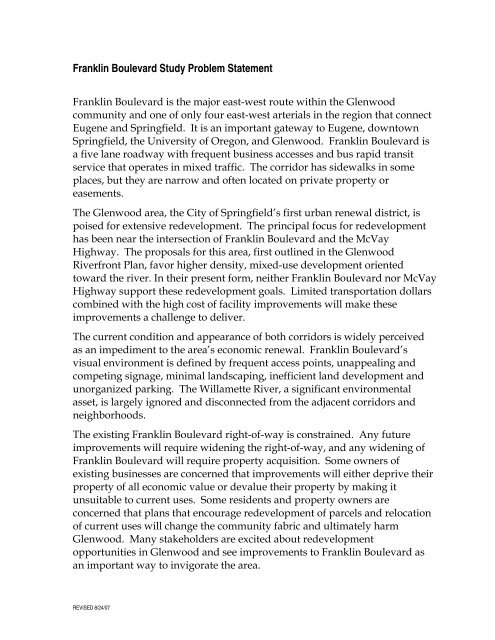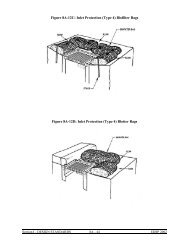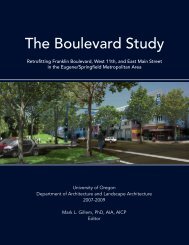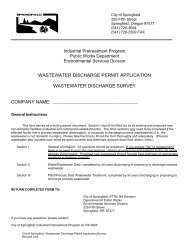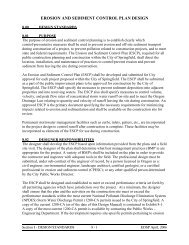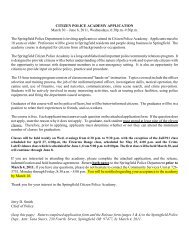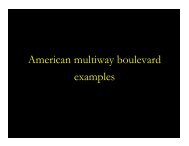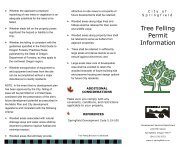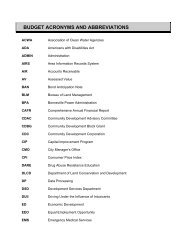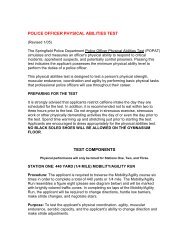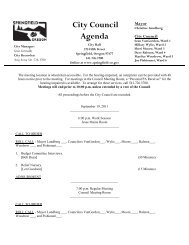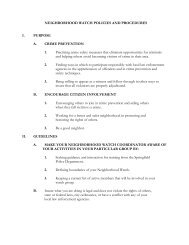Franklin Boulevard Study - City of Springfield
Franklin Boulevard Study - City of Springfield
Franklin Boulevard Study - City of Springfield
Create successful ePaper yourself
Turn your PDF publications into a flip-book with our unique Google optimized e-Paper software.
<strong>Franklin</strong> <strong>Boulevard</strong> <strong>Study</strong> Problem Statement<br />
<strong>Franklin</strong> <strong>Boulevard</strong> is the major east-west route within the Glenwood<br />
community and one <strong>of</strong> only four east-west arterials in the region that connect<br />
Eugene and <strong>Springfield</strong>. It is an important gateway to Eugene, downtown<br />
<strong>Springfield</strong>, the University <strong>of</strong> Oregon, and Glenwood. <strong>Franklin</strong> <strong>Boulevard</strong> is<br />
a five lane roadway with frequent business accesses and bus rapid transit<br />
service that operates in mixed traffic. The corridor has sidewalks in some<br />
places, but they are narrow and <strong>of</strong>ten located on private property or<br />
easements.<br />
The Glenwood area, the <strong>City</strong> <strong>of</strong> <strong>Springfield</strong>’s first urban renewal district, is<br />
poised for extensive redevelopment. The principal focus for redevelopment<br />
has been near the intersection <strong>of</strong> <strong>Franklin</strong> <strong>Boulevard</strong> and the McVay<br />
Highway. The proposals for this area, first outlined in the Glenwood<br />
Riverfront Plan, favor higher density, mixed-use development oriented<br />
toward the river. In their present form, neither <strong>Franklin</strong> <strong>Boulevard</strong> nor McVay<br />
Highway support these redevelopment goals. Limited transportation dollars<br />
combined with the high cost <strong>of</strong> facility improvements will make these<br />
improvements a challenge to deliver.<br />
The current condition and appearance <strong>of</strong> both corridors is widely perceived<br />
as an impediment to the area’s economic renewal. <strong>Franklin</strong> <strong>Boulevard</strong>’s<br />
visual environment is defined by frequent access points, unappealing and<br />
competing signage, minimal landscaping, inefficient land development and<br />
unorganized parking. The Willamette River, a significant environmental<br />
asset, is largely ignored and disconnected from the adjacent corridors and<br />
neighborhoods.<br />
The existing <strong>Franklin</strong> <strong>Boulevard</strong> right-<strong>of</strong>-way is constrained. Any future<br />
improvements will require widening the right-<strong>of</strong>-way, and any widening <strong>of</strong><br />
<strong>Franklin</strong> <strong>Boulevard</strong> will require property acquisition. Some owners <strong>of</strong><br />
existing businesses are concerned that improvements will either deprive their<br />
property <strong>of</strong> all economic value or devalue their property by making it<br />
unsuitable to current uses. Some residents and property owners are<br />
concerned that plans that encourage redevelopment <strong>of</strong> parcels and relocation<br />
<strong>of</strong> current uses will change the community fabric and ultimately harm<br />
Glenwood. Many stakeholders are excited about redevelopment<br />
opportunities in Glenwood and see improvements to <strong>Franklin</strong> <strong>Boulevard</strong> as<br />
an important way to invigorate the area.<br />
REVISED 8/24/07


